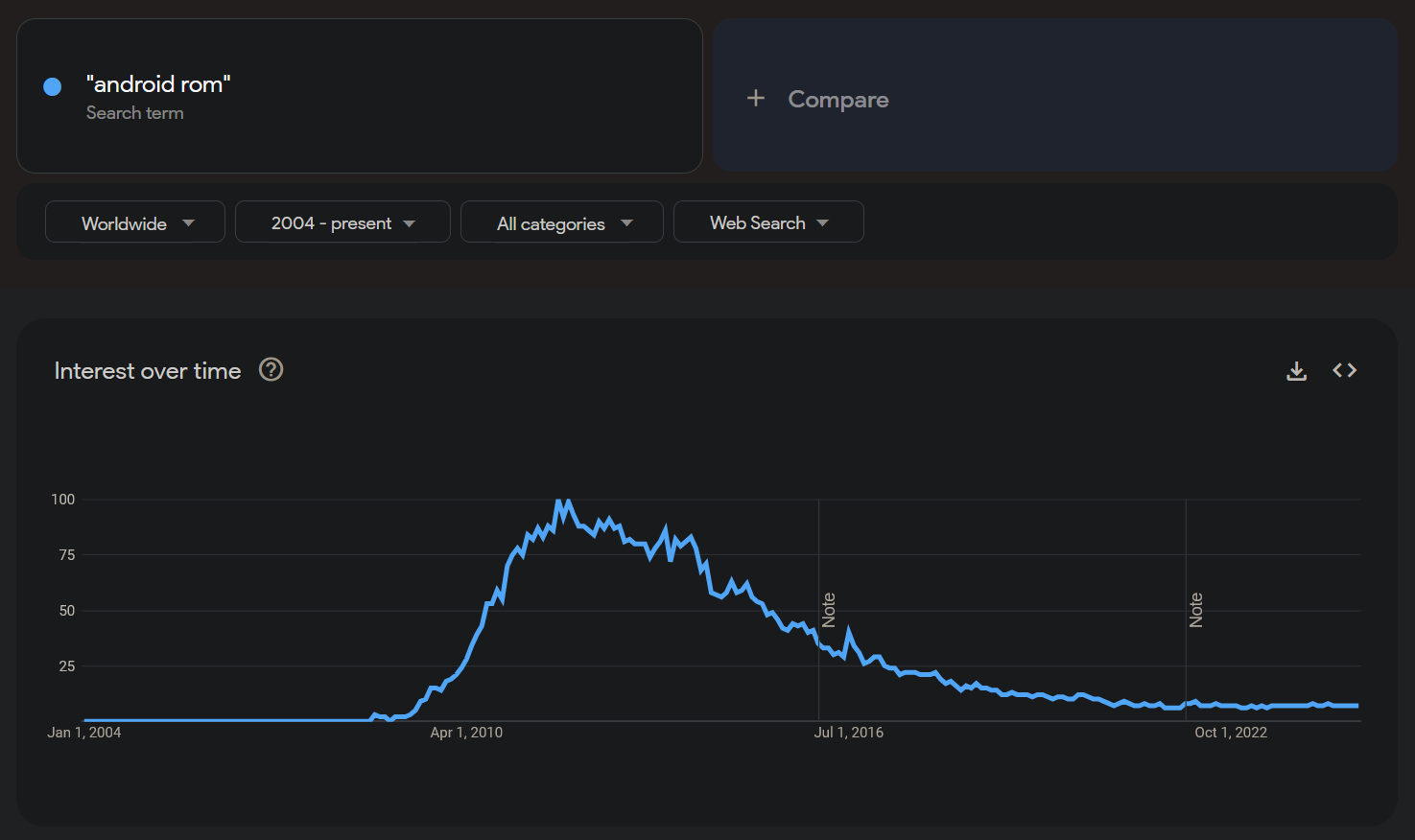So recently I’ve been seeing the trend where Android OEMs such as Google, Samsung, etc. have been extending their software release times up to like five, six, and seven years after device release. Clearly, phone hardware has gotten to the point where it can support software for that long, and computers have been in that stage for a very long time. From what I can tell, the only OEM that does this currently might be Fairphone.
Edit: The battery is the thing that goes the fastest so manufacturers could just offer new batteries and that would solve a lot of the problem.
The vendors like you to buy a new phone every year so that they can get more money from you.
When they advertise that “only our latest product has smart thingy, or picture erase, or circle to search”, they’re really telling you that they are trying to find a reason for you to throw perfectly good hardware away so that you can spend more money.
If the software lasts that long, and it’s doing what you need, there’s no reason you have to buy a new phone each year.
Every time you keep your phone a bit longer instead of buying a new one, you’re reducing the waste that goes to landfill (let’s be honest, most people throw their obsolete electronics literally in the trash rather than direct them to approved recycling and disposal).
They could have always supported software for that long. They simply refused to.
There is no benefit to slowing the release cycle. All of the research gets done either way, all of the supply chain modifications get made either way, and as an individual you have no need to replace your phone every year. A multi-year release cycle does very little but screw over people who need a new phone during the wrong point in the release cycle, while also substantially complicating the supply chains by making demand much spikier.
Compare with the yearly release cycle on cars.
People apparently use installment plans for phone purchases these days, along with a downstream used market, so it’s actually a really apt analogy.
That is kind of my thought. Phone technology doesn’t change drastically within two years and a car does not change drastically within two years.
Typically they’ll do a major revamp or a clean sheet design of a model, so the 2005 Hoyota Civrolla is a completely new car. The 2006 Civrolla will be available in a few different paint colors and 2 different wheel options. The 2007 model has a different grille so it looks even more like it’s smiling while wearing a retainer. The 2008 model has a different washer bottle assembly and the battery tray is now molded plastic instead of stamped steel. The 2008 model is available with a 2.7 liter engine in addition to the 3.6. 2009 they eliminate the base model trim so now they all have power mirrors and cruise control. The 2010 models with CD players can now play mp3s off the CD. 2011 they only sell the 6-speed manual with the 2.7 liter engine, the V6 is only available with an automatic. 2012 they do a major style update, same chassis and running gear, different bodywork and the interior shares more components with the Elamry.
But people are constantly buying millions of both, so makes sense to have small yearly updates and major revisions every few years.
Which is basically how both phones and cars are developed now.
Good points
Edit: Though there was the point in the early to mid-2010s where hardware was improving so rapidly that it would have been infeasible to not replace it as soon as possible.
Conservation wise there is a very big reason to slow down the release cycle
No, there isn’t. People who are buying new phones every year are trading them in, and they’re going to other people who are more price conscious.
Manufacturing several year old tech results in brand new hardware with a shorter life cycle. You’re not going to get 5 or 10 years of updates on a phone that was 5 years behind tech advancement when you bought it.
The people chasing novelty would do so by jumping manufacturers instead, so you don’t change their behavior at all.
And like you said, sometimes you need to replace a phone.
Maybe it was lost, or destroyed.
it has been for a few years already.
I just haven’t really seen it brought up as a point of discussion.
I mean it gets the customers status symbols and the manufacturers money. As long as those phones later end up on the used market it’s a win-win.
My pixel 4 I bought used years ago is still fine
Replying from my pixel 4a with grapheneOS. Phone just works, friendly pocketsize and with proper fingerprint reader.
OEMs only recently started offering 5+ years of security fixes. Two years was common until just 6 years ago. Apple got a lot of crap for not supporting older models but the truth is they supported longer than anyone else and only cut support when the hardware literally couldn’t take it. Yet everyone ignored that most android makers might not even release a single update much less more than the two years worth needed to cover a phone for a two year contract.
I don’t like saying that because I can’t stand apple devices. But it’s what happened. Then the EU started getting involved. They hated all this ewaste caused by people constantly upgrading. IT security people were speaking up too because phones were a complete risk with people using them for work but not getting updates that stopped them from being owned. It was getting bad for OEMs from multiple angles and they needed to act before the US government made them. And all those factors are the only reasons we are just now seeing all phones come with 5+ year plans.
As right to repair laws get integrated into new releases we will actually be able to take advantage of these 5+ year plans because we will be able to replace the batteries that are normally useless after three years.
I wish most phones had a battery saver option that would stop charge at 80% unless you manually overrode it each and every time you wanted to go over. This would dramatically cut down on the need to replace batteries.
But here is the rub. Even if you convince the majority logically that their phone is still good at year three they are going to upgrade at year two when the phone is paid off. The people that use phones as an identity and brand marker are still going to upgrade as fast as new devices come out.
And devices are going to continue to come out yearly. If you don’t ship a new flagship product each year then shareholders will revolt. There must always be something new for the customer. Technology moves fast. If you are an OEM not releasing then you are an OEM that isn’t keeping up.
All these forces of market, psychology, legal and repairability and more fight each other to create a situation where most people will upgrade in two years or less. Only a small portion of people will ever try to get 5+ years out of a device. Even the population trying to get 3 years will be two standard deviations out of the majority. Even if the battery is replaceable and the security patches keep coming.
The whole idea of making phones disposable was stupid from the get go. I’d say that most mid-tier phones from 2017 should be perfectly serviceable for every stupid app being widely used nowadays. High end phones from 7, 8 years ago are still perfectly fine
I mean, even power gamers barely need all the power that the high end phones offer, because mobile games always aim for the low end, with few exceptions.
That fucking Apple started with the stupid shit of gluing the phone, and every other fucking company copied that shit, really pisses me off. 2015 phones could have their backs opened and the battery changed if needed, no need for special tools.
Phones are unlikely to become open, as in owners can actually fuck around with the software and hardware as they’d like, anytime soon. A few try that, but it’s unlikely to become mainstream because there’s no market pressure
I just went with the $100 Motorola stylus (it has a built in stylus!) and just pay $4/month with 0% interest so I’m paying much less than $100 over two years. These cheaper phones usually hold up better to abuse than more expensive phones. I had the pixle 5a and the screen died just after two years (a known issue) screens for it are more expensive than $100 right now.
4*24=96, you’re probably paying exactly $100 over two years.
Not a huge savings, but still.

another way of looking at it.

What’s the NPV of 24 monthly $4 payments assuming a 4% annual rate of return?
At least $3.50
Yeah, up until about 2 weeks ago I was still using a Pixel 4. It was 5 years old but never felt slow at all.
Still rocking the Pixel3. Waiting on appleSE refresh
From what I can tell, the only OEM that does this currently might be Fairphone.
Does what? I don’t see anything in the sentences before that “this” could refer to.
Apparently they use one of the faster IoT chips that’s supported for like 10 years.
There is no CPU that is ever going to be supported for 10 years for a consumer application. ARM CPUs today are 20x faster than they were 10 years ago, and the ARM/RISC-V chips a decade from now will likely be 10-20x faster than today.
Regardless, the Kryo 670 CPU in the Fairphone 5 is already 3.5 years old, and it’s not super special, it’s just a semi-custom Snapdragon SoC. Consider that 4G LTE launched 13 years ago in the USA, and in 10 years that Kryo chip in the FP5 will be older than that. Could you handle the performance of your last 3G phone today?
We passed that when iPhone x hit
Manufactures are not going to offer replacement part, its more valuable for them to make you buy a new phone than replace a part yourself
They will with batteries since the EU is forcing the issue starting in 2026.
It’s been time for like 10 years
The “problem” exists on purpose. You can’t swap the os on your phone. You can’t repair it You can’t inspect how much it spies on you Your phone hates you.
Well, I have to disagree with being able to swap the OS on your phone as I have definitely been doing that for a very long time with the custom ROM scene. And in fact, I am on lineage OS right now with no Google Play Services so you can stop a lot of that crap.
I know there are rare exception, but for most phones and most people that simply is not an option.
That used to be the case but the practice was dying by 2014 and completely flatlined after 2020
Without drastic legislative changes, it will become entirely impossible and soon

I very seriously doubt it would become entirely impossible because if it became entirely impossible on any big brand name to do so then somebody would launch a brand that specifically allowed for that. Fairphone is somewhat that way already.
As the total number user of alternative phone OS shrinks, the development of those OS becomes less and less viable. But yes, I would see phones with mid tier specs from 3 years ago charging flagship prices to fill that the spot before it becomes entirely non-viable. I think google does need there to be the appearance of competition so they don’t get hit with monopoly lawsuits, but it only needs to exist, other than that they want it as fringe and clunky as possible and I think that’s where we’re headed.
I have never bought a new phone every year…
I tend to use mine until it’s EOL or until the battery is unusable.
So far I normally get 4-5 years out of my phones.
I usually buy high end devices, that tend to last 4-6 years. I usually choose by camera, battery, and charging speed. I’m currently on a 4 year old Xiaomi that has an great camera, the battery still last over a day, charges 5000 mAh in slightly over an hour. I have never broken a screen or lost a phone in over 30 years. I buy the latest and greatest to make sure my investment lasts.
I tend to buy the last years iPhone when I get a new phone, it is cheaper and has less bugs.
I am still on the iPhone 12 mini
Since everyone here has the big brain idea of telling you you’re dumb for not just buying a phone every couple years (completely missing the point of what you were asking), I’ll take a minute to actually answer your question.
Yes. Annual refreshes are way too frequent for technology this mature. Slowing it to every other year instead (maybe software releases on odd years, hardware on even?) would dramatically reduce costs and improve stability. Changes would have time to be thoroughly rested and implemented, and they’d get more use out of the same design (including components, molds, tooling, etc.). It would actually be better for manufacturers too, in that it would be more efficient (they’d make slightly less money, but with significantly less work and investment), but they would never do it. Manufacturers don’t succeed by being good at what they do, they succeed by manipulating the meta. Regular releases keep your brand on people’s minds. Timing your announcements and making a big deal about it makes a huge difference (everyone wants to be the hot thing in Q4 so people buy them for Christmas), and brands don’t want to miss an opportunity.
The annual cycle is a marketing tactic. And it honestly works, so I think it’s probably here to stay.
I didn’t really have any reason to listen to them because I already do not buy a new phone every year and keep them for as long as I can.
They ought to release a new phone every six months so morons keep buying them and my stocks continue to soar.









